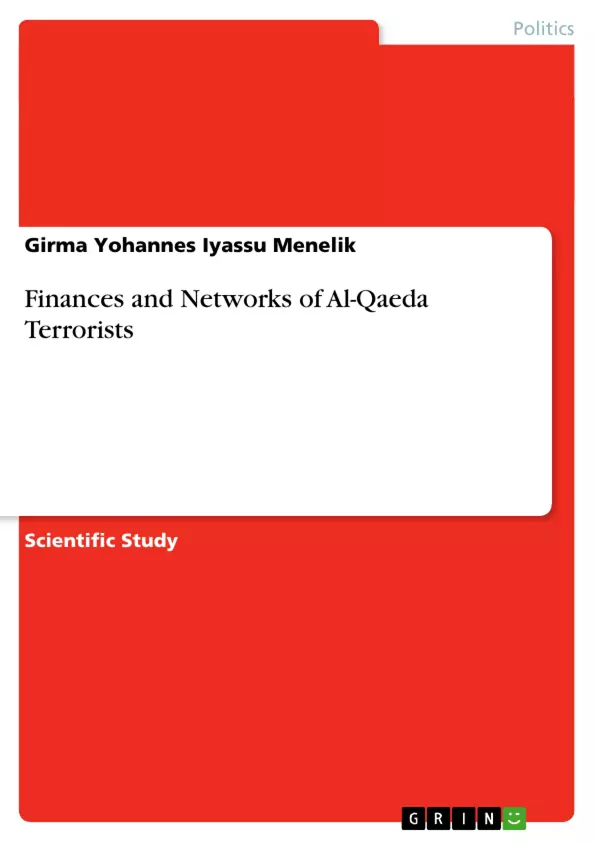The al Qaeda terrorist network and its sources of funding seem very complicated and mysterious at large. And much of what we know may only be speculation. The CIA has estimated, for example, that it cost Al Qaeda’ some $30 million a year to sustain itself during the period preceding 9/11, but the agency is still not sure what al Qaeda needs or expends today.
What we know today is the modified money transfer system of Al-Qaeda, the way it moves funds around the globe. Before September 11, many financial institutions have helped transfer millions of dollars of al-Qaeda’s money, without any problem.
However, after greater inspection over the past transactions, other policies were created to prevent legal transmission of terrorist funds after 9/11. Today terrorists are increasingly using the informal hawala, a very historical transaction system. To transport the huge amount of cash money, diamonds and gold they use donkeys, mules and horses to transport to the very remote areas.
Inhaltsverzeichnis (Table of Contents)
- I. The Financial Sources of Al Qaeda
- I.1. The Al Qaeda's Financial Networks
- I.2. Bin Laden's Personal Funds and Businesses
- II. Al Qaeda's Financial Facilitators
- II.1. The International Islamic Relief Organization and Charities (IIRO)
- II.2. Funds from Muslim World League in Mecca
- II.3. The Benevolence International Foundation (BIF)
- II.4. The Al Haramain Islamic Foundation
- II.5. The Muwafaq Foundation "Blessed Relief" Charity
- II.6. The Rabita Trust (RT)
- III. Al Qaeda from Saudi Arabia to the Continents
- III.1. Hasan Al-Turabi and Osama Bin Laden
- III.2. Kenya: Terrorism and Radical Groups
- III.3. Kenya: Corruption and Transnational Terrorism
- III.4. Al Qaeda and Al Itad Al Islamia Networks in Somalia
- III.5. Yemen, Philippines and Malaysia Connections
- III.6. Europe: Liechtenstein, Switzerland and Italy
- III.7. United States of America and Canada
- IV. Taliban-Al Qaeda International Drug Business
- V. South-East Asia-Indonesia Networks
- V.1. The Indonesian Ulama' Council (MUI)
- V.2. The Opposition against MUI
- V.3. A Radical Islamic Movement
- V.4. Al Qaeda's Money Men in Southeast Asia
- VI. The New Terror Front in North-West Africa
- VI.1. Future Plans of Al Qaeda-GSPC Alliance
- VI.2. Global Tactics and Fundraising
- VI.3. GSPC'S Growing International Network
Zielsetzung und Themenschwerpunkte (Objectives and Key Themes)
This monograph provides an overview of the financial sources and networks of Al-Qaeda terrorists. It explores the complex and often hidden mechanisms employed by the organization to secure funding and expand its global reach. The text delves into the history and evolution of Al-Qaeda's financial activities, tracing its roots to the anti-Soviet jihad in Afghanistan and its subsequent transformation into an international terrorist movement.- Al-Qaeda's financial networks and their evolution over time
- Key financial facilitators and their role in supporting Al-Qaeda operations
- The use of charitable organizations and other mechanisms to disguise and move funds
- The geographical expansion of Al-Qaeda's networks and its reach across continents
- The involvement of Al-Qaeda in international criminal activities such as drug trafficking
Zusammenfassung der Kapitel (Chapter Summaries)
Chapter I provides a detailed analysis of Al-Qaeda's financial sources, including the organization's internal financial networks and the personal funds and businesses controlled by Osama Bin Laden. It explores how Al-Qaeda utilized existing financial infrastructure, such as charitable organizations, to raise and transfer funds across borders. Chapter II examines the key financial facilitators who played a significant role in providing financial support to Al-Qaeda. It details the involvement of organizations like the International Islamic Relief Organization (IIRO) and the Benevolence International Foundation (BIF) in funneling money to the terrorist group. Chapter III explores the geographical expansion of Al-Qaeda's networks, covering its presence in various countries including Kenya, Somalia, Yemen, the Philippines, Malaysia, Europe, and North America. It examines the connections between Al-Qaeda and local radical groups, highlighting the organization's ability to build alliances and exploit local conflicts to further its goals. Chapter IV analyzes the involvement of Al-Qaeda in the international drug trade, demonstrating the organization's willingness to engage in illicit activities to secure financial resources. Finally, Chapter V explores the growing presence of Al-Qaeda in Southeast Asia, particularly in Indonesia. It examines the organization's strategies for fundraising and its use of local radical movements to further its aims.
Schlüsselwörter (Keywords)
This monograph examines the complex financial network of Al-Qaeda terrorists, delving into the organization's use of charitable organizations, financial facilitators, and illicit activities to secure funding. The work focuses on the global reach of Al-Qaeda, its geographical expansion, and its connections with local radical groups. Key concepts include terrorist financing, transnational terrorism, the role of Islamic charities, international drug trafficking, and the evolving nature of Al-Qaeda's financial strategies.- Quote paper
- Professor. Dr. Girma Yohannes Iyassu Menelik (Author), 2008, Finances and Networks of Al-Qaeda Terrorists, Munich, GRIN Verlag, https://www.grin.com/document/135817



